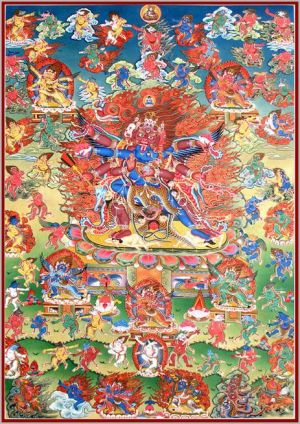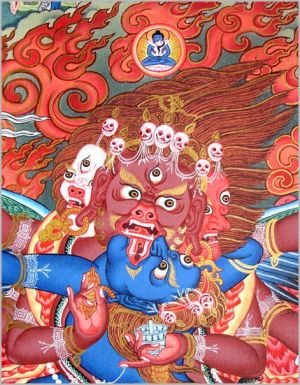Chemchok Heruka
Chemchok Heruka (Skt. Mahottara Heruka; Tib. ཆེ་མཆོག་, ཆེ་མཆོག་ཧེ་རུ་ཀ་, Wyl. che mchog he ru ka) — the main deity in the mandala of the fifty-eight wrathful deities (the wrathful aspect of Samantabhadra). Chemchok Heruka is also the central deity in the mandala of Tsokchen Düpa and Kagyé.
Chemchok Heruka has twenty-one heads and forty-two hands. The two principal hands hold Samantabhadra and Samantabhadri. His twenty hands on the right side hold the five buddhas of the five families, the eight bodhisattvas, the four male gatekeepers as well as three of the six munis – those who emanate in the three higher realms.
And the twenty left hands hold the five buddha consorts, the eight female bodhisattvas, the four female gatekeepers and the three munis who emanate in the three lower realms. The deities in the right hands are all male and the deities in the left hands, with the exception of the three munis, are all female. These forty-two deities are the peaceful deities of the mandala of the hundred peaceful and wrathful deities.
The consort of Chemchok is Namshyalma (Tib. གནམ་ཞལ་མ་, Wyl. gnam zhal ma).
She has nine heads and eighteen hands. Her main central hands hold a vajra and skull-cup (Skt. kapala). The eight hands on her right hold the wrathful manifestations of the eight bodhisattvas, known as the eight gaurima and then the eight on the left hold the wrathful emanations of the eight female bodhisattvas known as the eight singhama.
The One Hundred Peaceful and Wrathful Deities of the Bardo the period between death and rebirth are an extremely popular theme in Tibetan art. This thangka depicts the Fifty-Eight Wrathful Deities of the Bardo.
Against a rudimentary landscape appear numerous deities that are related to the transmigratory visions in the Bardo "Between-State" - the period between death and rebirth. These visions appear from the consciousness, according to the teaching of the Bardo Thodrol, the Book That Liberates when Heard in the Bardo, popularly known in the West as "The Tibetan Book of the Dead".
The dark, reddish brown winged central figure is Chemchok Heruka. He has three faces, six arms, and four legs, and embraces his bright blue consort in sexual union. He is the wrathful form of Samantabhadra, the primordial Buddha, whose peaceful yab yum [father - mother] form appears in a small circle above his head.
Around the central figure are five other Heruka Buddhas, each associated with one of the Five Buddha Families. They are wrathful deities embracing their consorts. There also are eight Kerimas female deities that appear in the Bardo in human form, four animal headed protectors, and eight animal headed Dakini goddesses. Dakini are "skywalkers"; they are powerful females, usually divine and usually enlightened, with mundane counterparts.
In the lower right corner Rahul, the god of planets is depicted. Rahul is one of many deities who entered the Buddhist pantheon of Tibet and Mongolia from tantric Hinduism, and whose nature is wild and paradoxical. As ruler of all the greater und lesser planets, he holds a particularly important place in the pantheon of the Tibetan Buddhism, and is generally viewed as a protector of the faith. But he also is a dangerous figure, the bearer of illness and the swallower of the sun and moon during eclipses.
Rahul has a snake's body with a large, gaping mouth in his belly, which emits an effluvium of illness. His torso and four arms are covered with eyes [one thousand is the number given in texts]. His nine stacked horrible heads are crowned with flaming hair and the head of a raven, who guards religious teachings and whose shadow was believed to cause apoplexy. Rahul leans back to draw his bow to shoot an arrow into the heart of anyone who breaks their religious vows.
External Links
Source
Chemchok Heruka (che mchog he ru ka).
Most Supreme (che mchog). Chemchok Heruka. Usually identical with Nectar Quality, the chief heruka of the ratna family. Sometimes, in the case of Assemblage of Sugatas, the Most Supreme is the heruka who embodies all the buddha families.

